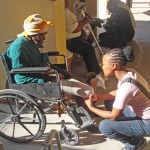A. When it is shown in a pornographic magazine, film or website.
B. Never.
C. When it is emailed to government officials urging action to improve public health.
One could argue about A and B but this blog is [...]]]>

By Paula Modersohn Becker
When is a photo of a woman giving birth considered pornographic? Take your pick:
A. When it is shown in a pornographic magazine, film or website.
B. Never.
C. When it is emailed to government officials urging action to improve public health.
One could argue about A and B but this blog is about C.
Earlier this year, in Zambia, Chansa Kabwela, news editor at the feisty opposition newspaper The Post, was charged with circulating pornography with intent to corrupt public morals. What was her crime? During a nationwide strike by Zambia’s miserably paid doctors, a woman allegedly gave birth without medical assistance in a hospital car park. The baby was in a breech position and later died.
Her family sent Kabwela the photos but she found them too graphic for publication. Instead, she emailed them to the vice-president and other government officials and women’s groups, urging a negotiated end to the strike to avoid more deaths.
President Rupiyah Banda found the photos “morbid and peculiar” and Kabwela, a 29-year-old mother of two, was charged with the porn offence, which carries a five-year jail sentence. The state argued that giving birth is sacred in Zambia and the photos were disrespectful.
If giving birth is so sacred, why was the woman delivering in a car park?
Good sense prevailed and in November a judge acquitted Kabwela.
The Post has long been harassed by government for exposing corruption. This court case is one more instance, using birth, women and tradition as a cover to erode press freedom.
A very famous Christmas birth
This being the season of a famous birth, on the other side of the world, in New Zealand, a mischievous billboard about the immaculate conception has angered Catholics. 
It shows Joseph and Mary in bed. She looks blissful; he looks dejected. The kicker: “Poor Joseph. God is a hard act to follow.”
The twist is that the originator is an Anglican archdeacon who commissioned an ad agency to produce a Christmas poster. The archdeacon argues, somewhat confusedly, that the purpose was to highlight that Christmas is about love, not about Mary’s impregnation by God.
Within hours the billboard was defaced with brown paint. Well, at least this is better than rioting over caricatures of the Prophet or charging an editor with pornography.
Giving birth is charged with cultural meaning: it can be sacred, pornographic, joyful, “eculiar” or offensive. For half a million women, every year, it is deadly.
Yet these deaths do not spark the same outrage as a billboard or photographs.
My wish this Christmas is quite simple: safe delivery for women everywhere, not in a car park and not in a manger, neither holy nor unholy, whether through sex, artificial insemination or immaculate conception. Just safe.
***
Read about why maternal mortality remains so intractable here and about midwives in India.
]]>http://www.campaignforrealbeauty.ca/bblank.asp?id=6895
Digital cosmetic surgery – nip-and-tuck, botox and liposuction, on the screen, with a click – render these models picture-perfect (excuse the pun) and thoroughly unreal.
There [...]]]>
http://www.campaignforrealbeauty.ca/bblank.asp?id=6895
Digital cosmetic surgery – nip-and-tuck, botox and liposuction, on the screen, with a click – render these models picture-perfect (excuse the pun) and thoroughly unreal.
There is no way a non-photoshopped woman can attain that perfection. Hey, we are human. We have flaws.
In France and the UK, women lawmakers recently proposed that ads should disclose when their photos have been digitally manipulated to a great extent. They argue that bodily digital perfection in ads undermines the body image and self-esteem of girls and women.
Anorexia, bulimia, eating disorders, obsession with thinness and unnecessary cosmetic surgery follow. Meanwhile, sales of weight-loss products and push-up bras soar.
The tricky problem for lawmakers and advertisers alike is where to draw the line between (acceptable) touching up a pimple or a wrinkle and engaging in full (unacceptable) deception.
Among the most egregious offenders: the French magazine Paris Match nipped the bulging love handles of President Nicholas Sarkozy, in evidence while he canoed bare-chested in the USA.
Oprah Winfrey always has a waist in the cover of O magazine, while flat-chested Keira Knightley miraculously acquired big boobs for her recent Chanel Mademoiselle perfume ad.
The alcoholic drink Campari must have some magical effects on bones because actress Jessica Alba got sharper collarbone and knee definition, longer arms and a tinier waist in its recent ad.
Eating disorders once afflicted mostly affluent white teen girls in the West. Now they have spread across the world, among all ages and ethnic groups and, increasingly, among young men.
It is harder to quantify how the unreal perfect bodies in ads distort the self-image of girls and boys worldwide.
Watch the video and share your thoughts about the proposed disclosure measures.
]]>Have you seen the Italian documentary Il corpo delle donne (available with English subtitles)?
It is horrifying, like a horror movie.
“Women –real women— are an endangered species on television, one that is being replaced by a grotesque, vulgar and humiliating representation,” says an introduction to the documentary [...]]]>
Have you seen the Italian documentary Il corpo delle donne (available with English subtitles)?
It is horrifying, like a horror movie.
“Women –real women— are an endangered species on television, one that is being replaced by a grotesque, vulgar and humiliating representation,” says an introduction to the documentary by Lorella Zanardo.

This picture shows a woman hanged from the ceiling, like a ham, surrounded by legs of ham. This and other images, taken from real TV shows, speak for themselves.
Il corpo delle donne is a 25-minute terrifying documentary that undresses the degradation of women in Italian television.
“This led us to select television images that share a common manipulative exploitation of the woman’s body, to let people know what is happening –not only people who never watch television, but especially those who watch it but ‘don’t see’,” says the introduction.
Why aren’t women, and men, rallying against this treatment?
Link with Il Corpo delle Donne in Facebook.
]]>A screw-on hand and the slogan: “Fake watches are for fake people. Be authentic. Buy real.”
The ad is part of a campaign against counterfeiting launched by the Geneva-based Fondation de la Haute Horlogerie last month.
I might have [...]]]>

A screw-on hand and the slogan: “Fake watches are for fake people. Be authentic. Buy real.”
The ad is part of a campaign against counterfeiting launched by the Geneva-based Fondation de la Haute Horlogerie last month.
I might have ignored it but the day I saw it in a magazine, I had been interviewing amputees and photographing artificial limbs, not unlike the hand in the ad, for a story.
Ndozi Xhaudi is a 79-year-old grandmother from Botswana who got a prosthetic leg through an aid group in June. For the first time in years, Xhaudi left the wheelchair and walked.
Tarina Coetzee, the physiotherapist who helped Xhaudi, recalls that it was her biggest dream to walk again. Now she could make tea and food for herself and be less of a burden on her family.
I spent time in Pretoria with Mohammad Saib, 13, who was born without legs. He goes to school, runs on the treadmill, and plays paintball thanks to his prostheses – you could call them fake limbs.

Ndozi Xhaudi. Courtesy ICExpress Progressive Prosthetics
I stared at the ad. How would Xhaudi and Saib feel about it?
I am sure the Fondation and its ad agency did not mean any disrespect. They probably never thought about a link between fake hands and real people with real needs.
This is part of the problem: the invisibility of people with disabilities.
Even the Millennium Development Goals forgot them, says the International Disability and Development Consortium. Disability is not included in MDG indicators and targets, although it affects all eight MDGs (see their slideshow).
Landmines and diamonds
This is not as surprising as it sounds. Disabled people consistently face discrimination and disadvantage. Eight out of ten live below the poverty line. One in five of the world’s poorest people are disabled, says the Consortium.
The World Bank estimates there are 300 million women with disabilities, and most live in poor countries. Moreover, women are the main carers of the disabled.
Women suffer gender-specific disabilities from obstructed labour, domestic violence and female genital mutilation. Blindness, multiple sclerosis and osteoporosis affect more women then men.
Besides disease, landmines and cluster bombs maim people. So do blood diamonds. In Sierra Leone’s diamond-fueled civil war, rebels hacked people’s arm at the elbow or the shoulder. They offered their victims a choice between “short sleeve or long sleeve”.
Last November, a fake (truly fake) satirical ad about blood diamonds annoyed South African diamond De Beers so much it tried to force the web provider to take down the offending website, which featured a hilarious spoof of the New York Times published on line and in print by a group of artists.
In the fake ad, a white female hand with a glittering diamond ring reaches out to a black prosthetic hand. The punch line: Your diamond purchase will enable De Beers “to donate a prosthetic for an African whose hand was lost in diamond conflicts.” See it here.
I have a friend who covered the civil war in Sierra Leone. Up to this day she can’t look at shops that have mannequins without arms. “My friends think I’m weird,” she says.
I don’t. I think she is sensitive to other realities far away from expensive, status-symbol watches and jewelry stores.
(Read about people with disabilities in Argentina, India and Tanzania.)
]]>